 Dense teeth are characterized by a lack of free space between them. In this case, the teeth go beyond the dental arch and grow in different directions, preventing each other from developing normally.
Dense teeth are characterized by a lack of free space between them. In this case, the teeth go beyond the dental arch and grow in different directions, preventing each other from developing normally.
In addition to the lack of aesthetic appearance, this pathology can cause considerable physiological and psychological discomfort in the patient.
Contents of
- Causes of pathology
- Stages and symptoms of
- Is there an urgent need for treatment?
- Complex of orthodontic care
- Than it is dangerous?
- Preventative measures
Causes of pathology
Causes that can cause development of crowding:
- Teething wisdom teeth. Since the G8s often begin to grow after all the teeth have taken their intended place in the jaw, they often do not have enough space for full development, and they are forced to press their "neighbors".
- Harmful habits acquired in childhood. The formation of an occlusion can be greatly influenced by: incorrect breathing( through the mouth), active sucking of fingers and infantile swallowing.
- Rapid replacement of molar teeth by indigenous ones.
- Different types of malocclusion.
- Underdeveloped alveolar processes.
- Pathology of soft tissues with subsequent abnormal development of dental arches.
- Teeth too broad.
Stages and symptoms
Depending on how pronounced the deviation is, there are several options for the development of dental crowding:
- Easy degree( 2-3 mm on one jaw).Teeth are located closely, but evenly, without disturbing the shape of the dental arches.
- Average degree( 4-6 mm).Characterized by severe changes in the position of one tooth, with no deviations in the location of the remaining teeth. In this case, the tooth can be tilted or turned around its axis.
- Heavy ( 7 and more mm).There is a pushing out of two teeth from the dentition. The alveolar process and the dental arch change their shape.
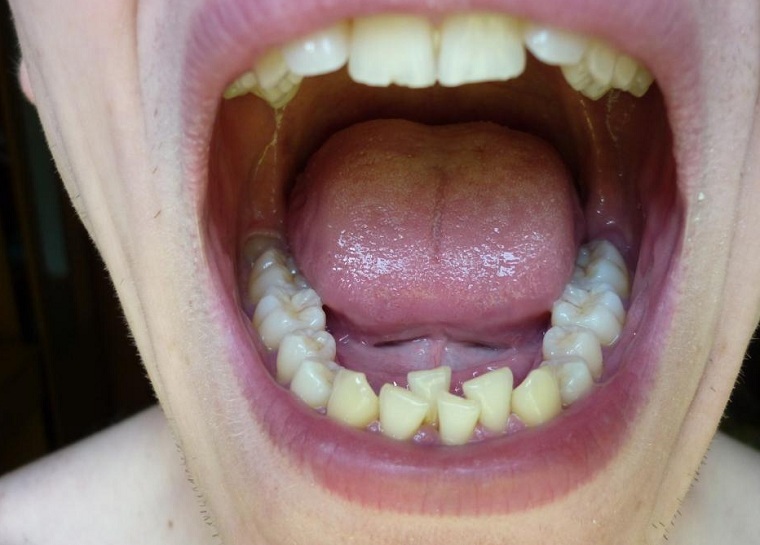
In the photo, the patient with the dullness of the lower jaw teeth of moderate severity
In addition to crowding, the patients experience inflammation caused by the multiplication of pathogenic bacteria. Quite often, doctors diagnose significant periodontal lesions and the presence of deep carious cavities.
Is there an urgent need for treatment?
Too high density of the dentition greatly complicates hygiene measures. The absence of gaps between the teeth leads to the development of such dental diseases as caries and periodontitis.
Late treatment of a doctor for advice can lead to more serious consequences. Inflammatory processes gradually become 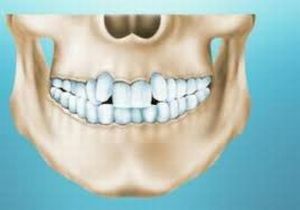 chronic form, there are purulent formations. Bone tissue is destroyed and ceases to perform its functions. The gums begin to bleed and swell, and the teeth - to loosen up and fall out.
chronic form, there are purulent formations. Bone tissue is destroyed and ceases to perform its functions. The gums begin to bleed and swell, and the teeth - to loosen up and fall out.
In addition to all the above troubles, with crowding the distribution of the masticatory load on the teeth occurs unevenly.
In some parts of the jaw there is an overload, resulting in the tissues surrounding the teeth, deformed and die. In the absence of treatment, such changes are irreversible and lead to premature loss of teeth.
Complex of orthodontic care
The main goal of treatment with crowding is the return of teeth to the boundaries of the dental arch. This will allow the dentition to take the correct location in the jaw and evenly distribute the chewing load between each other.
In childhood, doctors can limit themselves to simply monitoring the condition of the oral cavity. With a changeable occlusion, the treatment of crowding does not make sense, since replacing the molar teeth with the molars can significantly change the general picture of the arrangement of the dentition. Orthodontists recommend starting to deal with the problem of crowding not earlier than 11-12 years.
In addition to braces, for the treatment of crowding doctors use removable covers made of transparent material( eliners), which almost always need to be worn on the teeth.
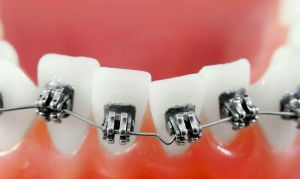 Braces can achieve significant results in the treatment of severe form of crowding. Specially selected orthodontic designs will help to move the teeth and deploy them in the right direction. First of all, the orthodontist will make a treatment plan based on a computer tomography study.
Braces can achieve significant results in the treatment of severe form of crowding. Specially selected orthodontic designs will help to move the teeth and deploy them in the right direction. First of all, the orthodontist will make a treatment plan based on a computer tomography study.
With the help of leveling systems, the dentist can not only tilt, but also expand the dentition. To fix the result after the braces are removed, the retainers are put on the teeth.
If there is a slight deviation from the norm, doctors suggest using separation. The areas of teeth contacting each other are neatly ground. Thus, a small space is formed between them, allowing the dentition to be moved.
In some cases, specialists come to the conclusion that to eliminate dental crowding, the patient needs to install veneers or crowns.
The removal is resorted only in the most extreme situations, when the teeth simply have nowhere to move because of the lack of distance between them.
The main applicants for extraction are "wisdom teeth", however the doctor can also use premolars in this process.
In the absence of two teeth in the mouth, a gap of 6-8 mm is formed, through which the orthodontic design will perform all the tasks assigned to it. If the procedure is carried out in time, then after removal, the remaining teeth themselves can take the right direction of growth.
Photos of patients before and after treatment and video cutting stepwise correction of crowded teeth invisible braces Win allows you to judge the possibilities of modern orthodontics:
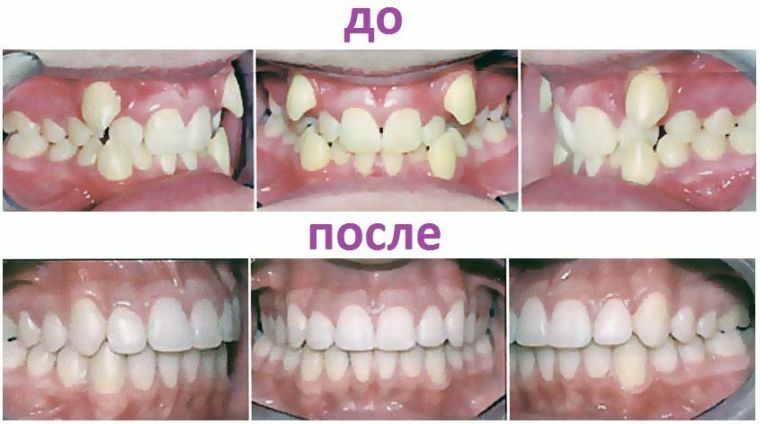
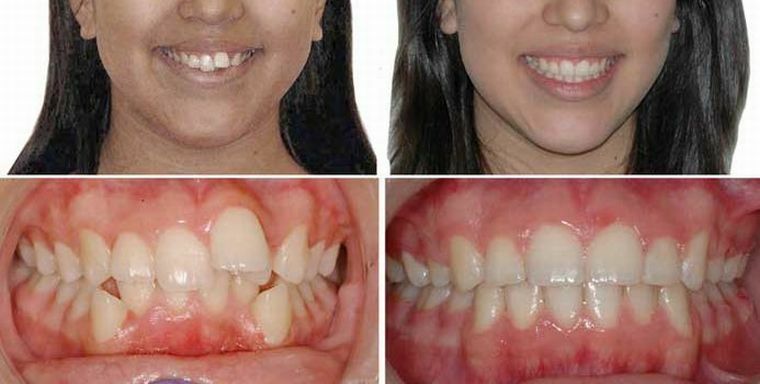
Than it is dangerous?
The absence of any anxiety symptoms is not a reason for frivolous attitude towards one's health. When excessive dental crowding in the oral cavity may form:
- plaque;
- periodontal disease;
- abscess;
- periostitis;
- fistula;
- traumatic bite.
Preventive measures
In order to prevent and timely detect abnormalities in the development of the dentoalveolar system, several simple rules must be adhered to:
- Regular visit to the dental office .It is during the preventive examination that the doctor has every chance of noticing the predisposition of the patient to this or that disease in time and preventing its appearance. In addition, professional cleaning of teeth will never be compared with the usual daily hygiene, conducted at home.
- Monitoring the development and condition of the dental jaw, starting with the child .Such foresight will help to save not only time, but money, because, as is known, the child's organism is more willing to meet changes. Therefore, the movement of teeth in children is much faster and painless than in adults.
- Healthy lifestyle .Proper nutrition and the absence of bad habits significantly increase the likelihood that the teeth will feel comfortable in the oral cavity.
- Control the loss of baby teeth .Early loss of non-permanent teeth must be compensated for by specially designed prostheses, which allow evenly distributing the load on the jaw.
To ensure that the treatment of tooth congestion is most effective, the patient needs to choose his dental clinic, which has achieved significant results in this field.
Of course, the recovery process will take some time. It may be necessary to have several designs for correction. It is important to tune in to a beautiful and smooth smile, which is sure to be a reward for patience!
